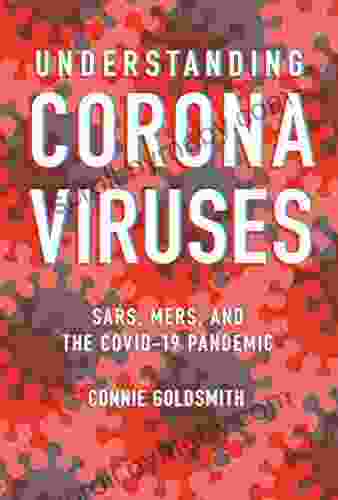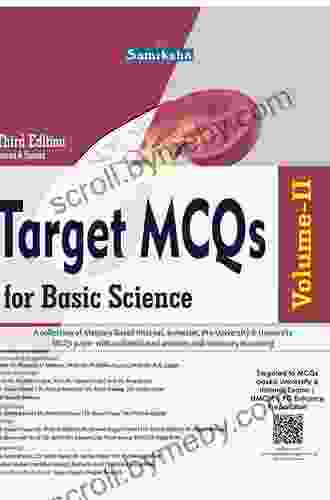Understanding Coronaviruses: SARS, MERS, and the COVID-19 Pandemic

Coronaviruses have emerged as formidable threats to human health, causing severe respiratory illnesses and global pandemics. This comprehensive guide delves into the intricate world of coronaviruses, exploring their biological characteristics, historical outbreaks, and the global impact of SARS, MERS, and COVID-19.
4.7 out of 5
| Language | : | English |
| File size | : | 12290 KB |
| Text-to-Speech | : | Enabled |
| Screen Reader | : | Supported |
| Enhanced typesetting | : | Enabled |
| Word Wise | : | Enabled |
| Print length | : | 161 pages |
Epidemiology of Coronaviruses
Coronaviruses belong to the Coronaviridae family, a diverse group of enveloped, positive-sense, single-stranded RNA viruses. They are zoonotic in nature, originating in animals and capable of infecting humans through close contact or airborne transmission.
Surveillance and research efforts have identified a wide range of coronaviruses, including human strains like HCoV-229E, HCoV-OC43, HCoV-NL63, and HCoV-HKU1, which typically cause mild respiratory infections.
However, certain coronaviruses have demonstrated a remarkable capacity for causing severe disease. SARS-CoV-1 emerged in China in 2002, triggering a global outbreak that infected over 8,000 people and claimed the lives of 774.
MERS-CoV emerged in the Middle East in 2012, causing sporadic outbreaks with a high fatality rate. As of 2023, MERS-CoV has infected over 2,500 individuals and resulted in more than 850 deaths.
Phylogeny and Evolution of Coronaviruses
Phylogenetic studies have revealed the evolutionary relationships between different coronaviruses. The SARS-CoV-1 and SARS-CoV-2 viruses share a common ancestor, suggesting their origin in horseshoe bats. MERS-CoV, on the other hand, is descended from bat coronaviruses but was likely introduced into camels before spilling over to humans.
Genetic recombination and mutation play significant roles in the evolution of coronaviruses. These processes can lead to the emergence of novel strains with enhanced infectivity, transmissibility, or virulence.
Pathogenesis and Clinical Manifestations
Coronaviruses primarily target the respiratory tract, binding to specific receptors on host cells. They then enter the cells and hijack their machinery to replicate, causing cellular damage and inflammation.
The clinical manifestations of coronavirus infections vary depending on the strain, viral load, and host immune response. Mild infections may present with fever, cough, sore throat, and muscle aches.
However, severe infections can lead to pneumonia, acute respiratory distress syndrome (ARDS),multi-organ failure, and death. SARS-CoV-1 and MERS-CoV are particularly known for their high fatality rates.
Prevention and Treatment of Coronavirus Infections
Preventing coronavirus infections involves a combination of public health measures and individual hygiene practices. Key strategies include:
- Maintaining good hand hygiene by frequent washing with soap and water or using alcohol-based hand sanitizers
- Practicing respiratory etiquette, such as covering coughs and sneezes with a tissue or elbow
- Avoiding close contact with individuals suspected of having respiratory infections
- Wearing masks in public places during outbreaks
Treatment for coronavirus infections depends on the severity of the illness. Mild cases may only require supportive care, such as rest, hydration, and pain relievers.
For severe cases, antiviral medications, corticosteroids, oxygen therapy, and mechanical ventilation may be necessary. Research is ongoing to develop more effective and targeted therapies against coronaviruses.
Impact of the COVID-19 Pandemic
The COVID-19 pandemic, caused by the novel coronavirus SARS-CoV-2, has had a profound impact on global health, society, and the economy.
Since its emergence in Wuhan, China, in late 2019, COVID-19 has spread to over 230 countries and territories, infecting millions and causing hundreds of thousands of deaths.
The pandemic has disrupted healthcare systems, businesses, and travel, leading to widespread economic and social consequences. Governments around the world have implemented various measures to contain the virus, including lockdowns, travel restrictions, and mass vaccination campaigns.
Coronaviruses have proven to be formidable pathogens, capable of causing severe respiratory illnesses and pandemics. Understanding the biology, epidemiology, and clinical manifestations of these viruses is essential for developing effective prevention and treatment strategies.
The ongoing COVID-19 pandemic has highlighted the importance of international collaboration, scientific research, and public health preparedness in mitigating the impact of coronavirus infections.
As we continue to navigate the challenges posed by coronaviruses, continued research and innovation will be crucial for developing novel vaccines, therapeutics, and public health interventions to protect human health and prevent future pandemics.
4.7 out of 5
| Language | : | English |
| File size | : | 12290 KB |
| Text-to-Speech | : | Enabled |
| Screen Reader | : | Supported |
| Enhanced typesetting | : | Enabled |
| Word Wise | : | Enabled |
| Print length | : | 161 pages |
Do you want to contribute by writing guest posts on this blog?
Please contact us and send us a resume of previous articles that you have written.
 Book
Book Novel
Novel Page
Page Chapter
Chapter Text
Text Story
Story Genre
Genre Reader
Reader Library
Library Paperback
Paperback E-book
E-book Magazine
Magazine Newspaper
Newspaper Paragraph
Paragraph Sentence
Sentence Bookmark
Bookmark Shelf
Shelf Glossary
Glossary Bibliography
Bibliography Foreword
Foreword Preface
Preface Synopsis
Synopsis Annotation
Annotation Footnote
Footnote Manuscript
Manuscript Scroll
Scroll Codex
Codex Tome
Tome Bestseller
Bestseller Classics
Classics Library card
Library card Narrative
Narrative Biography
Biography Autobiography
Autobiography Memoir
Memoir Reference
Reference Encyclopedia
Encyclopedia Cynthia Royce
Cynthia Royce John Patrick Daly
John Patrick Daly Mahtab Narsimhan
Mahtab Narsimhan Roy John
Roy John Claudio Irigoyen
Claudio Irigoyen Martin Meredith
Martin Meredith Colleen Doyle Bryant
Colleen Doyle Bryant Peter Sanczel
Peter Sanczel Paisley Rekdal
Paisley Rekdal Italo Svevo
Italo Svevo Terry Southern
Terry Southern Craig Sodaro
Craig Sodaro Sally Moran
Sally Moran Cynthia Bourgeault
Cynthia Bourgeault Francis Fukuyama
Francis Fukuyama Imbolo Mbue
Imbolo Mbue Clyde E Fant
Clyde E Fant Semion Vinokur
Semion Vinokur Jack D Schwager
Jack D Schwager Cylin Busby
Cylin Busby
Light bulbAdvertise smarter! Our strategic ad space ensures maximum exposure. Reserve your spot today!
 Fabian MitchellFollow ·9.9k
Fabian MitchellFollow ·9.9k Ethan MitchellFollow ·7.2k
Ethan MitchellFollow ·7.2k Keith CoxFollow ·15.3k
Keith CoxFollow ·15.3k Miguel NelsonFollow ·7.1k
Miguel NelsonFollow ·7.1k Frank ButlerFollow ·4.4k
Frank ButlerFollow ·4.4k Leo TolstoyFollow ·17.7k
Leo TolstoyFollow ·17.7k Randy HayesFollow ·19.5k
Randy HayesFollow ·19.5k Edwin CoxFollow ·5.6k
Edwin CoxFollow ·5.6k

 Cruz Simmons
Cruz SimmonsUnveiling the Secrets: An Insider Guide to School Bonds...
Unlock the Power of School...

 Gil Turner
Gil TurnerRuins of Empire: Blood on the Stars - The Epic Space...
Ruins of Empire: Blood on the Stars is the...

 Allen Ginsberg
Allen GinsbergPrepare for the Ultimate Space Opera: Delve into The Last...
Embark on an...

 Anton Foster
Anton FosterUnleash Your Inner Artist: The Ultimate Guide to Oil...
Chapter 1: The...
4.7 out of 5
| Language | : | English |
| File size | : | 12290 KB |
| Text-to-Speech | : | Enabled |
| Screen Reader | : | Supported |
| Enhanced typesetting | : | Enabled |
| Word Wise | : | Enabled |
| Print length | : | 161 pages |
















